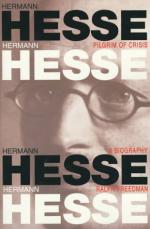|
This section contains 485 words (approx. 2 pages at 400 words per page) |

|
Hermann Hesse, Pilgrim of Crisis: A Biography Summary & Study Guide Description
Hermann Hesse, Pilgrim of Crisis: A Biography Summary & Study Guide includes comprehensive information and analysis to help you understand the book. This study guide contains the following sections:
This detailed literature summary also contains Topics for Discussion and a Free Quiz on Hermann Hesse, Pilgrim of Crisis: A Biography by Ralph Freedman.
Hermann Hesse, by Ralph Freedman, is the story of Nobel Prize winning writer Hermann Hesse. Hesse was born in 1877 in the German area of Swabia. He was the son of strict Pietists who had a missionary background in India and were prominent in the Basel Institute, a Pietist organization. His background and upbringing result in a great deal of conflict and he was plagued with mental illness for his entire life. His problems began when he was a child. His parents considered him to difficult to handle and put him in boarding school at the mission in Basel when he was six.
Hesse could not deal with formal education and its authoritative structure. He was constantly in and out of schools and was also institutionalized as a child. His parents had hoped he would attend he seminary but he didn't make it past his first term. After that, their goal was to have him achieve the necessary level of education so he would only have to serve one year in military service. He barely succeeded in attaining this level.
He began composing poems at the age of six. He had an older half brother who rebelled against his parents plans to apprentice him to a pharmacist. He auditioned at a music conservatory and secured a place. Even though he failed in his singing career, the young Hermann associated the arts with rebellion against parents. In spite of his emotional problems, he finally decided to set out on his own and took a position as a bookseller apprentice in Basel, where he lived on his own. He wrote in his sparse time and had some of his poems published. Hesse stayed on as a regular employer for another year and then left to work less hours at a used bookstore so he could devote more time to writing.
Hesse traveled a great deal, constantly going to spas and clinics for treatments and cures. He alternated living between Calw, Basel and Zurich before he made a permanent home in Montagnalo, Italy, in the Italian Lakes District. Hesse had three sons by his first wife. His first two marriages ended in divorce , but his third marriage to Ninon lasted for three decades until his death in 1962.
This book examines the life of Hesse and how events and crises in his personal life were reflected in his writing. His writings exemplified his internal conflict and search for resolutions. When he began to experience eye problems, and feared blindness, his writing included many things that were visually pleasing, like colors and landscapes. When he began to lose his sight, his writing emphasized music and math as in The Glass Bead Fame for which he won the Nobel Prize for Literature in 1946.
This book is a fascinating history of Hesse. The reader will enjoy this book even if he/she is unfamiliar with the works of Hesse.
Read more from the Study Guide
|
This section contains 485 words (approx. 2 pages at 400 words per page) |

|



